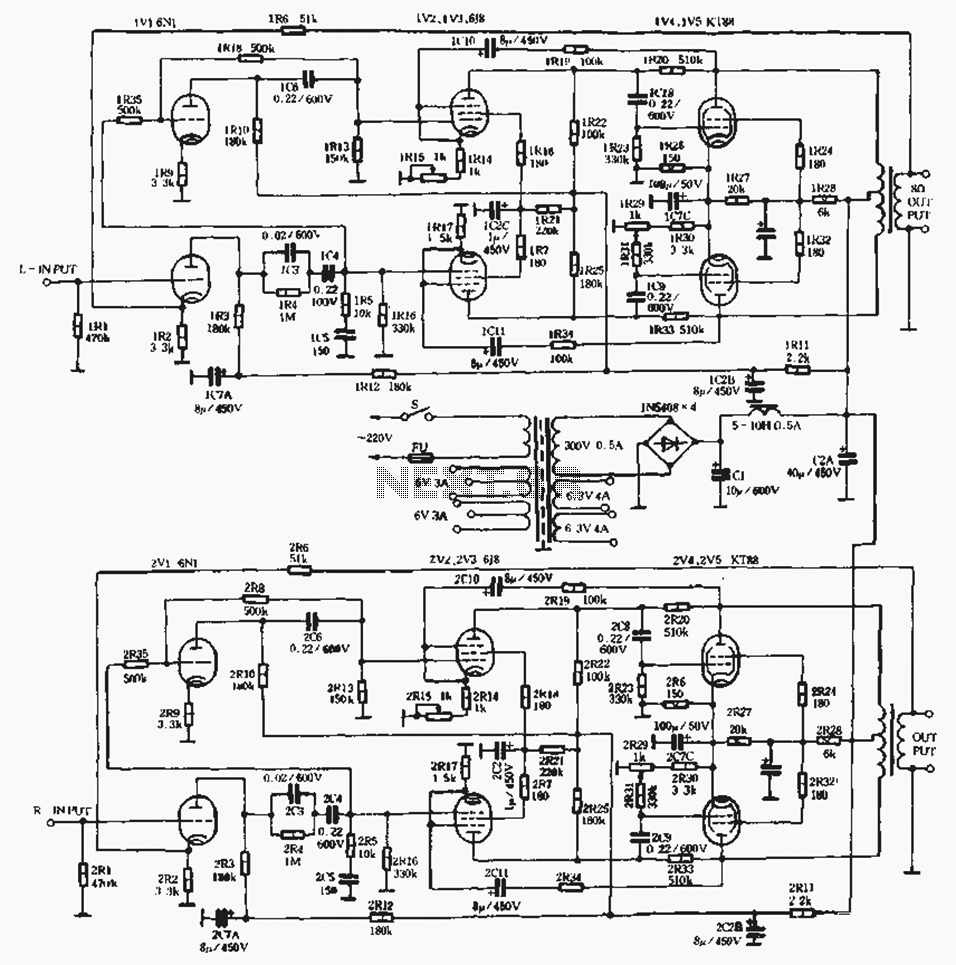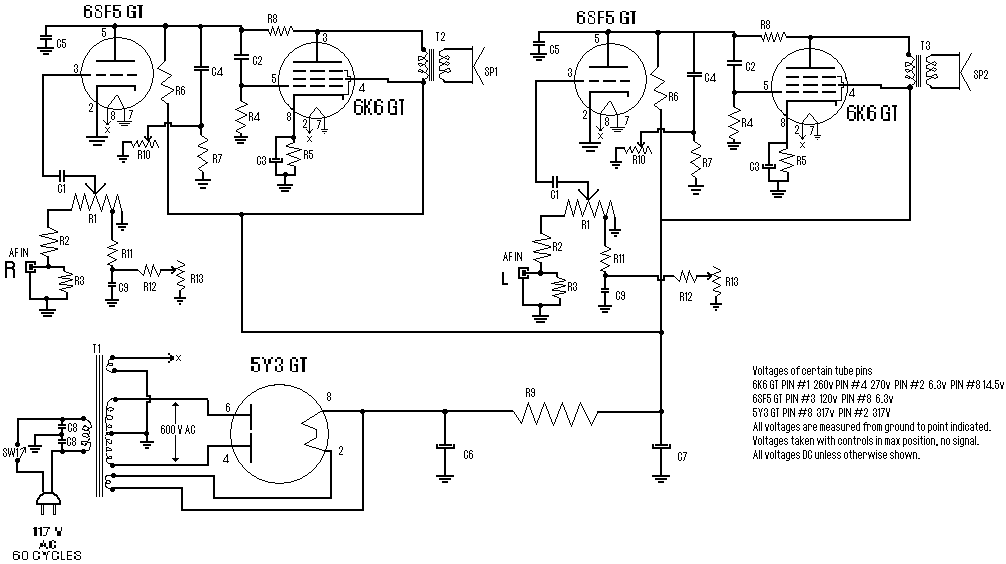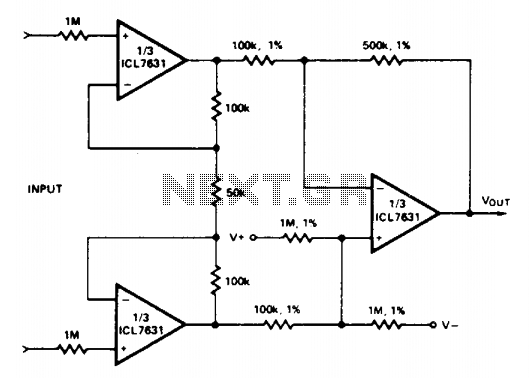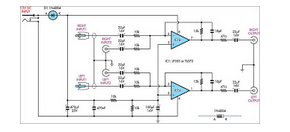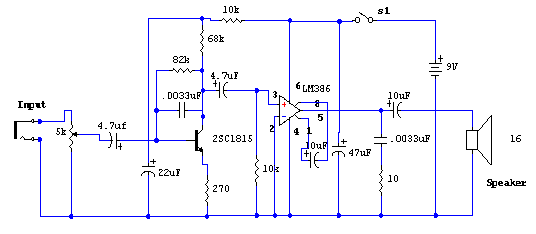
Walkman amplifier II
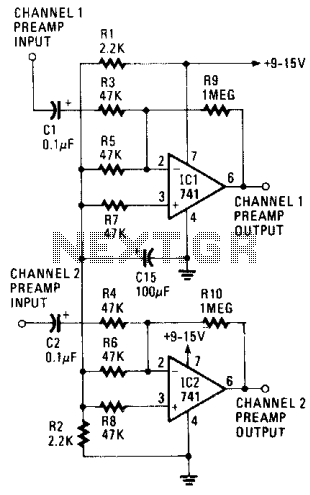
The gain of the low-cost integrated circuit (IC) is internally fixed at no less than 34 dB (50 times). A unique input stage allows input signals to be referenced to ground. The output is automatically self-centering to one-half the supply voltage. Additionally, the output is short-circuit proof and includes internal thermal limiting. With a maximum supply voltage of 15 volts and an 8-ohm load, the output is approximately 1.5 watts per channel. The input stage can handle signals ranging from 50 mV to 500 mV RMS. When using the amplifier with a source other than a personal stereo, such as a phonograph or an electric guitar, a preamplifier is required. A suitable circuit is provided, which utilizes two 741 operational amplifiers (op-amps) configured as input amplifiers. Their input stages are referenced to a common point—half the supply voltage. This reference voltage is derived from a voltage divider consisting of R1 and R2, two 2.2 kΩ resistors. The gain of each 741 op-amp is fixed at 21 by the input resistors (R9, R10). Input capacitors, C1 and C2, are employed to filter out any DC component from the input signal.
The described circuit employs a low-cost integrated circuit designed for audio amplification, ensuring a minimum gain of 34 dB, which is suitable for various audio applications. The self-centering output feature simplifies design by maintaining a stable output voltage at half the supply voltage, enhancing compatibility with various audio loads. The short-circuit proof design, coupled with thermal limiting, protects the circuit from potential damage due to overload conditions, ensuring reliable operation over extended periods.
The input stage of the amplifier is versatile, accommodating a range of input signal levels from 50 mV to 500 mV RMS. This flexibility allows it to interface with different audio sources, including personal stereos, phonographs, and electric guitars. However, when connecting sources that output lower signal levels, such as electric guitars or turntables, a preamplifier is essential to boost the signal to an appropriate level for the amplifier.
The circuit featuring the two 741 op-amps is a classic configuration that provides the necessary gain and signal conditioning. The reference voltage for the op-amps is established through a voltage divider formed by two 2.2 kΩ resistors (R1 and R2), which ensures that the op-amps operate around a stable midpoint voltage. The gain setting for each op-amp is achieved using input resistors (R9 and R10), which are tailored to achieve a gain of 21. This configuration provides sufficient amplification while maintaining signal integrity.
Moreover, the inclusion of input capacitors (C1 and C2) plays a crucial role in removing any DC offset from the incoming audio signals. This ensures that only the AC components of the audio signals are amplified, thereby preventing distortion and ensuring high-quality audio output. The overall design reflects a balance between simplicity, functionality, and performance, making it an effective solution for various audio amplification needs.The gain of the low-cost IC is internally fixed so that it is not less than 34 dB (50 times). A unique input stage allows input signals to be referenced to ground. The output is automatically self centering to one half the supply voltage. The output is also short-circuit proof with internal thermal limiting. With a maximum supply of 15 volts and an 8 ohm load, the output is around 1.5 watts per channel. The input stage is usable with signals from 50 mV to 500 mV rms. If the amplifier is to be used with a source other than a personal stereo, such as a phonograph or an electric guitar, some type of preamplifier is required. A suitable circuit is shown. In that circuit, two 741 op amps have been configured as input amplifiers. Their input stages referenced to a common point—half the supply voltage. That voltage is derived from a voltage divider made up of Rl and R2, two 2.2 k resistors. The gain of each of the 741's has been fixed at 21 by the input resistors (R9, RIO). Input capacitors; Cl and C2, are used to-filter out any dc component from the input signal than a personal stereo, such as a phonograph or an electric guitar, some type of preamplifier is required. A suitable circuit is shown. In that circuit, two 741 op amps have been configured as input amplifiers. Their input stages referenced to a common point—half the supply voltage. That voltage is derived from a voltage divider made up of Rl and R2, two 2.2 k resistors. The gain of each of the 741's has been fixed at 21 by the input resistors (R9, RIO). Input capacitors; Cl and C2, are used to-filter out any dc component from the input signal. 🔗 External reference
The described circuit employs a low-cost integrated circuit designed for audio amplification, ensuring a minimum gain of 34 dB, which is suitable for various audio applications. The self-centering output feature simplifies design by maintaining a stable output voltage at half the supply voltage, enhancing compatibility with various audio loads. The short-circuit proof design, coupled with thermal limiting, protects the circuit from potential damage due to overload conditions, ensuring reliable operation over extended periods.
The input stage of the amplifier is versatile, accommodating a range of input signal levels from 50 mV to 500 mV RMS. This flexibility allows it to interface with different audio sources, including personal stereos, phonographs, and electric guitars. However, when connecting sources that output lower signal levels, such as electric guitars or turntables, a preamplifier is essential to boost the signal to an appropriate level for the amplifier.
The circuit featuring the two 741 op-amps is a classic configuration that provides the necessary gain and signal conditioning. The reference voltage for the op-amps is established through a voltage divider formed by two 2.2 kΩ resistors (R1 and R2), which ensures that the op-amps operate around a stable midpoint voltage. The gain setting for each op-amp is achieved using input resistors (R9 and R10), which are tailored to achieve a gain of 21. This configuration provides sufficient amplification while maintaining signal integrity.
Moreover, the inclusion of input capacitors (C1 and C2) plays a crucial role in removing any DC offset from the incoming audio signals. This ensures that only the AC components of the audio signals are amplified, thereby preventing distortion and ensuring high-quality audio output. The overall design reflects a balance between simplicity, functionality, and performance, making it an effective solution for various audio amplification needs.The gain of the low-cost IC is internally fixed so that it is not less than 34 dB (50 times). A unique input stage allows input signals to be referenced to ground. The output is automatically self centering to one half the supply voltage. The output is also short-circuit proof with internal thermal limiting. With a maximum supply of 15 volts and an 8 ohm load, the output is around 1.5 watts per channel. The input stage is usable with signals from 50 mV to 500 mV rms. If the amplifier is to be used with a source other than a personal stereo, such as a phonograph or an electric guitar, some type of preamplifier is required. A suitable circuit is shown. In that circuit, two 741 op amps have been configured as input amplifiers. Their input stages referenced to a common point—half the supply voltage. That voltage is derived from a voltage divider made up of Rl and R2, two 2.2 k resistors. The gain of each of the 741's has been fixed at 21 by the input resistors (R9, RIO). Input capacitors; Cl and C2, are used to-filter out any dc component from the input signal than a personal stereo, such as a phonograph or an electric guitar, some type of preamplifier is required. A suitable circuit is shown. In that circuit, two 741 op amps have been configured as input amplifiers. Their input stages referenced to a common point—half the supply voltage. That voltage is derived from a voltage divider made up of Rl and R2, two 2.2 k resistors. The gain of each of the 741's has been fixed at 21 by the input resistors (R9, RIO). Input capacitors; Cl and C2, are used to-filter out any dc component from the input signal. 🔗 External reference
Warning: include(partials/cookie-banner.php): Failed to open stream: Permission denied in /var/www/html/nextgr/view-circuit.php on line 713
Warning: include(): Failed opening 'partials/cookie-banner.php' for inclusion (include_path='.:/usr/share/php') in /var/www/html/nextgr/view-circuit.php on line 713
